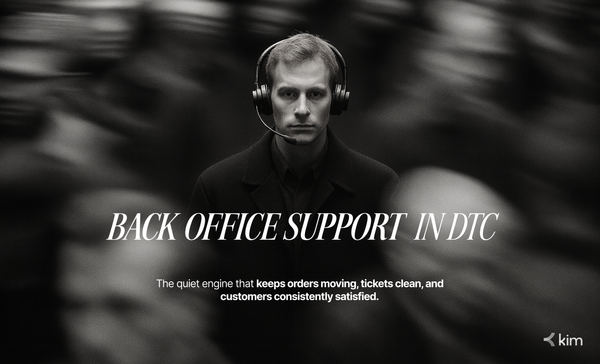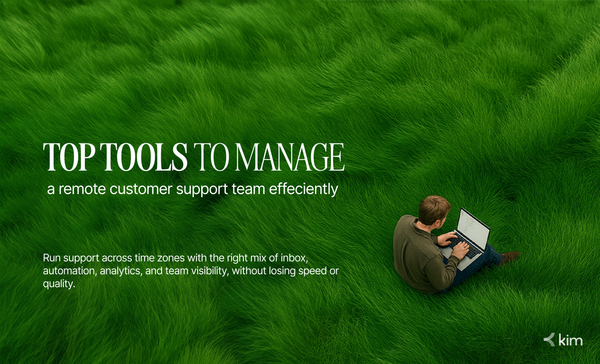How to Leverage Automation to Personalise Customer Service in Your Business

In the age of Direct-to-Consumer (DTC) brands, customer experience reigns supreme. Gone are the days of generic interactions with faceless corporations. Today's consumers crave a personalized touch, a sense of connection that fosters brand loyalty. But how can DTC brands, often operating with lean teams, deliver exceptional service while maintaining scalability? The answer lies in the strategic use of customer service automation.
What is Customer Service Automation?
Customer service automation refers to leveraging technology to handle repetitive tasks and streamline support processes. This can encompass a wide range of tools, from chatbots and self-service portals to automated ticketing systems and knowledge base creation.
Personalization vs. Automation: Finding the Sweet Spot
Personalization and automation might seem like opposing forces. However, when used together effectively, they create a powerful synergy. Personalization allows you to tailor interactions to individual customer needs, while automation frees up your human agents to focus on complex issues and build genuine relationships.
Here's a simple analogy: Imagine a bustling restaurant. A well-designed menu (self-service portal) allows customers to find basic options quickly. Meanwhile, the friendly waiter (human agent) can focus on special requests and personalized recommendations, creating a memorable dining experience.
5 Ways Automation Enhances Personalized Customer Service
1. Streamlined Onboarding and Self-Service:
Automated onboarding sequences can guide new customers through product setup and basic troubleshooting, freeing up agents for more complex inquiries. Zendesk reports that 67% of customers prefer self-service options, so providing a robust knowledge base and FAQs can significantly reduce support tickets.
2. Personalized Chatbots with Context Awareness:
Chatbots powered by AI can answer simple questions, provide real-time order tracking, and even personalize product recommendations based on past purchases or browsing behavior. This reduces wait times and allows human agents to jump in for more nuanced issues.
3. Automated Ticket Routing and Prioritization:
Automation can analyze customer queries and route them to the most qualified agent based on expertise and past interactions. This ensures faster resolution times and a more personalized experience for the customer.
4. Proactive Customer Outreach:
Leveraging historical data, you can automate personalized outreach to anticipate customer needs. For example, sending automated reminders for product refills or loyalty program updates shows customers you care and adds a valuable touchpoint.
5. Sentiment Analysis and Personalized Follow-Up:
Automation can analyze customer support interactions to identify frustration or dissatisfaction. This allows for proactive follow-up from human agents, addressing potential issues and demonstrating your commitment to customer satisfaction.
3 Myths Debunked About Customer Service Automation
Myth #1: Automation Makes Customer Service Impersonal:
Kim Kardashian West, entrepreneur and DTC brand owner, understands the power of human connection. However, automation doesn't replace human agents; it empowers them. By handling routine tasks, automation frees up agents to provide more personalized attention and build rapport with customers.
Myth #2: Automation is Only for Large Businesses:
Today's customer service automation software is designed to be scalable and affordable. Even small DTC brands can leverage chatbots, self-service portals, and ticketing systems to personalize the customer experience without breaking the bank.
Myth #3: Automation Eliminates the Need for Customer Service Agents:
Absolutely not! Automation complements human agents, not replaces them. Skilled agents remain crucial for handling complex issues, providing empathy, and building long-term customer relationships.
Building a Winning Customer Service Automation Strategy
Here's how to implement a customer service automation strategy that fosters personalization:
- Identify High-Volume, Low-Complexity Tasks: Analyze your current support channels to pinpoint frequently asked questions and repetitive requests. These are prime candidates for automation through chatbots, self-service portals, or knowledge base articles.
- Gather Customer Data Responsibly: Collect and leverage customer data ethically, with clear opt-in procedures and transparent privacy practices. This data empowers you to personalize automated responses, product recommendations, and proactive outreach.
- Prioritize Customer Journey Mapping: Map your ideal customer journey, pinpointing key touchpoints where automation can enhance the experience. This might involve automated welcome messages, post-purchase tutorials, or personalized feedback requests.
- Invest in the Right Tools: Choose customer service automation tools that integrate seamlessly with your existing systems and offer customization options. Look for features like AI-powered chatbots, sentiment analysis, and automated ticket routing.
- Measure and Refine Continuously: Don't set it and forget it! Regularly monitor key metrics like customer satisfaction scores, resolution times, and self-service portal usage. Use this data to refine your automation strategy and ensure it's delivering the desired results.
Conclusion
By embracing customer service automation, DTC brands can create a win-win situation. Customers receive faster, more efficient support tailored to their needs, while brands benefit from increased scalability and improved agent productivity. Remember, automation is a tool, and like any tool, its effectiveness lies in how you use it. Leverage automation strategically to personalize your DTC brand experience and watch customer satisfaction soar.
Scared to lose your brand’s voice? Try Kim to take charge of the brand voice by tracking adherence to brand guidelines, ensuring consistency in messaging and identity. Schedule a free trial with Kim.




